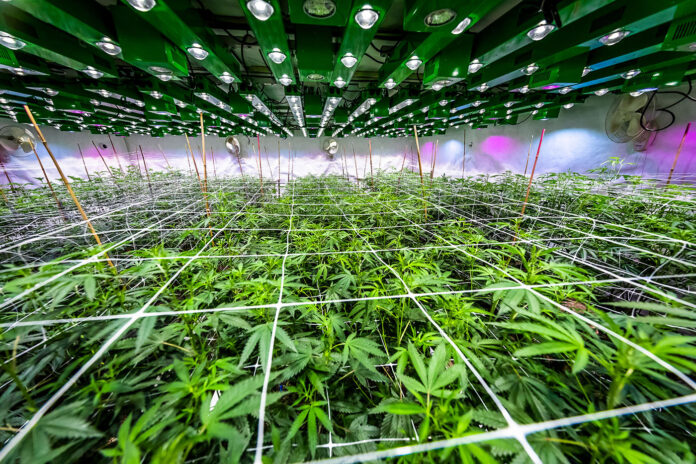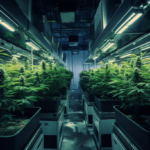Delivering quality product and high yields while maintaining efficiency in a licensed indoor cannabis cultivation operation can be challenging, and the challenges increase with scale. Growers have made large investments in their facilities and crops and would like to deliver an early return on their investments. Or maybe growers have been in their current facilities for some time but are dissatisfied with batch inconsistencies or low yields. They may need to get better productivity from their workforce. Using advanced automated controls to manage and maintain the environment in an indoor facility can help growers achieve those goals.
By tightly managing growing conditions, automated controls allow cultivators to develop, monitor, and manipulate the entire environmental recipe to produce at the highest level. Efficient environmental management encourages crops to grow more effectively and with less risk of damage or low yields. Instead of manually adjusting lighting and humidity, growers can use automation tools to control and change all variables throughout the growing cycle.
Environmental recipes
Producers can create an environmental cannabis growing recipe by scheduling the conditions for the phases of growth. These same tools can gather data that shows the exact growing conditions used to achieve optimal yields and quality for each plant variety. Automated controls also reduce the potential for human error and help workforces focus on other tasks.
Since the data is stored and can be used to show what parameter changes helped or hurt growth, controls can help producers experiment with various growing conditions. Controls may be set to repeat parameters that created great quality outcomes or boutique blends with consistent flavor and potency, creating the opportunity to market higher-quality products at a higher price. As growers experiment and learn, the controls can help consistently repeat successes.
Many facilities use different rooms for each phase of plant growth, moving the plants between rooms. These phase-specific rooms can have relatively consistent conditions. Still, the approach requires more rooms to handle the various crops and mechanisms and labor to move plants multiple times during a grow cycle. By using environmental recipes, growers can program a single room to maintain specific conditions tailored to various growth phases. Thus, a room can be used for multiple phases, minimizing plant movement during the growing cycle. As an added benefit, more crops and several varieties may be in production simultaneously within a given building and number of rooms.
Data and regulations
Automation and validation already are requirements for some producers and will be required of more growers as regulations for the industry continue to evolve. Data is (or will be) needed to validate products meet a particular set of growing and storage conditions to ensure their quality. Regulations vary by location, but the consensus is increased regulation is just a question of when and how much, not whether. An automation system can be a vital tool for mandatory data collection and storage.
A building management system (BMS), sometimes known as a building automation system (BAS), works with a web-based user interface to streamline facility management. Typically, a BMS/BAS is accessible from most PCs, tablets, and smartphones, and it can be a flexible, cost-effective solution for programming and managing facility conditions. BMS/BAS systems also can control lighting, monitor energy consumption, and integrate with equipment that controls other processes, such as CO2 injection and plant fertigation.
With a BMS/BAS, wireless communication sensors measure temperature and relative humidity in multiple locations in a grow room, providing flexibility and multiple points of sensing. BMS/BAS systems use temperature and relative humidity to calculate the vapor pressure deficit, which is critical to optimize plant growth. Humidity control also reduces the potential for mold and other plant diseases that thrive in high humidity. Sensors can be positioned in multiple locations in a room to measure the varied conditions—or microclimates—around the space.
Sensors also can measure CO2 and lighting levels, if desired. CO2 injection may be controlled separately or integrated, or monitored with the automation system. Lighting levels can be coordinated to provide maximum intensity to compensate for lighting location and fixture intensity while also scheduling day and night cycles with a gradual transition to simulate sunrise and sunset. Levels of lighting intensity for various phases of plant growth can be set as part of the environmental recipe.
Reduce labor costs
Instead of relying on workers to walk around the facility and manually change thermostat settings, turn lights on and off, and control CO2 levels, all those functions can be automated and controlled from just one point. Instead of constantly moving plants to another room to achieve correct environmental conditions, growers can change the conditions in a single room. These changes can be made manually using the BAS/BMS user interface options or automated to follow a prescribed growing schedule (with manual adjustments if needed).
Operators can feel confident conditions are controlled by preset programs or environmental recipes: Lights are turned on and off at certain hours of the day and adjusted to varying intensity, and temperature and humidity are tightly in line. If levels fall outside set parameters, the system can alert the operator with a text message or other form of notification.
To dial in what automation equipment works best for a cultivation facility, an HVAC specialist will work with the grower to identify the following factors:
•The equipment used for heating, cooling, and dehumidification.
•Types of lighting and lighting controls.
•The environmental conditions required for various phases
of growth.
•CO2 levels and controls.
•Fertigation schedules by growth phase and fertigation processes.
With those considerations outlined, controls experts can make recommendations about the best fit for automation solutions.
Sustainability
Day cycles, with lights on, use much more energy than night cycles. The mechanical and electrical systems must have adequate capacity to handle the maximum number of rooms in a day cycle at any time. By staggering the day cycles between growing rooms, cultivators can dramatically reduce peak demand and the required system capacity. Many utilities offer cheaper rates at night and have peak demand charges during the day. Using automated controls helps reduce electrical demand upcharges and allows growers to capitalize on the most affordable time-of-day electricity rates.
A BMS/BAS can provide a secure way to manage large grow facilities or multiple grow facilities from any location. Operators can use the cloud-based system to view and track key performance metrics in customized dashboards and generate custom reports. With access to real-time data, operators can make decisions that improve plant growth and yields while reducing energy use and operating costs to continuously improve the growing process and the company’s bottom line. The data also can assist in complying with increasing regulations requiring validation of growing, plant processing, and storage operations.
Growers should consult an HVAC systems expert to see whether automated controls may help them increase productivity, troubleshoot, and enhance energy management, along with providing feedback that can help deliver higher crop quality, repeatability, and yields.












[…] also employs open-source, upgradeable software so grows may be automated. The TouchMi system allows growers to precisely program and monitor up to 512 lights and […]
[…] said high-quality cannabis is hard to come by in just about every state on the East Coast. This gives craft growers an […]
[…] One gram of weed is enough to roll one joint or pack two bowls; it’s typically the smallest quantity of marijuana flower a dispensary will sell to cannabis consumers. A gram of weed usually looks like a standard or average-size nug. Before recreational or medical marijuana were legalized in the United States, people colloquially referred to a gram of weed as a “dime bag” because it sold for about $10. Today, many dispensaries sell single grams of marijuana for around $15 depending on the quality of the product. […]